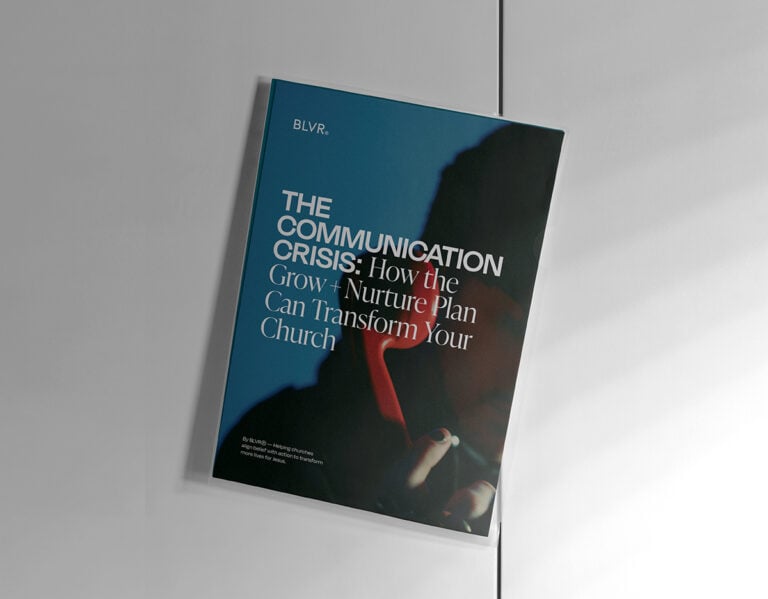
Church Branding / BY Scott Hancock
Your Church’s Trust Problem: Why What You Do Matters More Than What You Say
Published On 11.05.2024
Article
Your Congregation is Watching: Are Your Actions Backing Up Your Words?
Your church says it’s committed to serving the community. You preach about the importance of discipleship, inclusivity, or outreach. But here’s the hard truth: People are no longer just listening to what you say—they’re watching what you do. And if your actions don’t consistently match your words, the trust you’re trying to build will slowly erode, one missed opportunity at a time.
In a world that’s more skeptical of institutions than ever, it’s not enough to talk about your values or your mission. You must prove it through your actions. If people sense a gap between your church’s message and what actually happens within your walls, trust crumbles. This is known as the Say-Do Gap®, and it’s more dangerous than you think.
Every time your church fails to live out its stated beliefs, you give people a reason to disengage. They might stay for a while, but without the integrity of action behind your message, they will eventually lose faith—not just in your church, but in the mission you claim to stand for. And in the long run, that’s a loss you can’t afford.
The Say-Do Gap®: The Disconnect Between Words and Actions
The Say-Do Gap® is the space between what your church says it believes and what it actually does. It’s the distance between the inspiring messages shared from the pulpit and the lived reality of how the church operates day to day.
For example:
- Your church says it values community service, but you haven’t organized any tangible service opportunities in months.
- Your church says it’s welcoming to all, but newcomers sense cliques and exclusivity that make them feel like outsiders.
- You preach about the importance of discipleship, but there’s no clear pathway for members to grow in their faith or connect with mentors.
These subtle, but dangerous, inconsistencies quietly sabotage trust. The Say-Do Gap® is what causes a visitor to leave and never come back. It’s why your congregation might nod in agreement on Sundays but fail to follow through when called to action.
Why does this gap matter so much? Because people won’t trust a church that doesn’t practice what it preaches. Without trust, your church can’t build the strong relationships that form the foundation of a thriving ministry.
The Impact of the Say-Do Gap®: How It Slowly Erodes Trust
The Say-Do Gap® isn’t always obvious at first. It starts small. Maybe there’s a disconnect between a sermon series on generosity and how the church manages its finances. Or maybe you’ve spoken about inclusion, but there’s no real diversity reflected in your leadership or community events.
Each of these small inconsistencies creates doubt. That doubt grows, and before long, your congregation starts to wonder if your church is truly living out its mission. Worse, the community sees these gaps and questions your church’s sincerity.
Once people sense a lack of integrity between your words and actions, trust erodes. And trust, once broken, is difficult to rebuild. You may lose long-time members, struggle to attract new visitors, and find it harder to inspire people to serve, give, or participate in your programs.
Closing the Say-Do Gap®: Aligning Your Actions with Your Belief
The good news is, you can close the Say-Do Gap® and rebuild trust—but it requires intentional action. Closing this gap isn’t about doing more or adding extra programs. It’s about doing the right things, and doing them consistently.
You must ensure that every action your church takes, both big and small, aligns with your stated core belief. Consistency is essential. Without it, your words are just noise.
Here are three powerful steps to help you close the Say-Do Gap® and foster a culture of trust within your church.
Step 1: Conduct an Honest Audit of Your Church’s Actions
The first step to closing the Say-Do Gap® is to take an honest, thorough look at everything your church does. Are your ministries, programs, and resources aligned with your core belief? Where are the gaps, and where are you falling short?
This isn’t about assigning blame; it’s about transparency and accountability. As church leaders, you need to ask hard questions and be willing to hear the uncomfortable answers.
Ask yourself:
- Do our current programs truly reflect our core belief? If discipleship is central to your church, are there clear pathways for spiritual growth? If you preach about family values, are you investing in ministries that actually support families, or is this just something you talk about?
- Are our resources allocated in ways that support our mission? Look at where your church spends time, energy, and money. Does your budget reflect your core belief? Do your volunteers have a clear direction that aligns with your mission?
- Are we practicing what we preach? Review recent sermons, communications, and decisions. Are you taking action on the promises made to your congregation and community?
Action: Set aside time with your leadership team to audit your church’s actions. Review your programs, events, communications, and spending. Compare them against your core belief. Identify areas where your actions don’t align with your words and create a plan to address them.
Step 2: Prioritize Visible and Tangible Consistency in Your Actions
After identifying the gaps, it’s time to act. Consistency is the foundation of trust, and trust is built when your church consistently delivers on its promises. This requires intentionality in both communication and behavior. Your congregation and community are not just listening to what you say—they’re watching what you do.
Be visible. Be clear. Be consistent. Every message you share, every event you hold, and every decision you make must reflect your church’s core belief. It’s not enough to simply preach or share your mission in words; people want to see that mission lived out in practice. People don’t just want to hear about your mission—they want to see it lived out.
Here’s a key truth: When we believe something, we naturally want to share it with others—but people become believers by watching how we behave. Behavior proves belief. If your actions don’t align with what you say you believe, it erodes trust and credibility. Your community and congregation need to see that your church doesn’t just talk about serving others, discipleship, or inclusivity—it acts on those beliefs in real, meaningful ways.
Key areas to prioritize:
- Communication: Ensure that every touchpoint—from sermons to social media posts—clearly communicates your church’s core belief. Consistency across all platforms is critical. However, communication without action will fall flat, so it’s crucial that your communication is backed by visible, tangible behavior.
- Behavior: Every action your church takes should show that you’re living out your core belief. For example, if your church emphasizes community service, there should be regular, visible opportunities for your congregation to engage in service projects. Leadership should actively participate in these efforts, demonstrating that serving the community is a core part of your church’s identity.
Your congregation will notice if there’s a gap between your words and your actions. By consistently aligning what you say with what you do, you’ll show your congregation and community that your church’s belief is more than just words—it’s the foundation for everything you do. When they see your church consistently practicing what it preaches, trust will grow. When they don’t, that trust erodes.
Action: Create a system to track and ensure consistency in your church’s actions. Regularly review your communications, programs, and activities to make sure they align with your core belief. Make adjustments where needed, and consistently demonstrate that your church is following through on its promises, both inside the church and out in the community.
Step 3: Celebrate Proof of Alignment and Share It with the Church
Building trust requires more than just aligning your actions—it requires showing proof of that alignment. People need to see real examples of how your church is living out its core belief. This isn’t about self-promotion; it’s about demonstrating integrity and transparency.
For example, if your church’s mission is to reach the unchurched, celebrate every story of someone who found faith through your outreach efforts. If discipleship is your focus, highlight the spiritual growth of individuals in small groups or mentorship programs.
Action: Regularly share success stories and examples of how your church’s actions align with its core belief. Use testimonies, impact stories, and ministry reports to show your congregation and community that your church’s mission is being lived out in meaningful ways.
What Happens If You Don’t Close the Say-Do Gap®?
If you don’t address the Say-Do Gap®, you’ll continue to lose trust. And trust, once lost, is difficult to rebuild. When people see inconsistency between your church’s words and actions, they begin to disengage. They stop attending, stop volunteering, and stop giving.
Your church may still have people in the pews, but their hearts will no longer be in it. Worse, the community around your church will begin to view you with skepticism, seeing your messages as hollow promises rather than meaningful commitments.
What Happens When You Align Your Actions and Belief?
Now imagine this: your congregation is fully engaged because they see that your church is practicing what it preaches. They’re excited to serve because they know that every action, program, and initiative aligns with the core belief they share.
When your church consistently aligns its actions with its words, trust flourishes, and with trust comes engagement, growth, and deep, lasting impact.
YOUR NEW COMMS PLAN
Learn how your church can apply an approach that businesses have used to successfully acquire new customers and retain existing customers. Use the power of audience segmentation to deliver personalized messages that are relevant to each person within you external and internal church community.

About the Author

Scott Hancock
Partner / CEO
Scott Hancock is a thought leader in belief-driven branding and an expert in closing the Say-Do Gap®—the critical divide between what brands say and what they actually do. As CEO of BLVR®, Scott has pioneered a belief-led approach that helps organizations transform their core conviction into bold actions that inspire trust, loyalty, and market leadership.
With a reputation for pushing brands to go beyond surface-level promises, Scott’s work has been recognized by AdWeek, Forbes, and Fast Company for its fearless creativity and impactful results. His leadership has empowered BLVR® to become a trusted partner for purpose-driven brands seeking to align their actions with their core belief and create lasting change.
© BLVR
SD / CA




